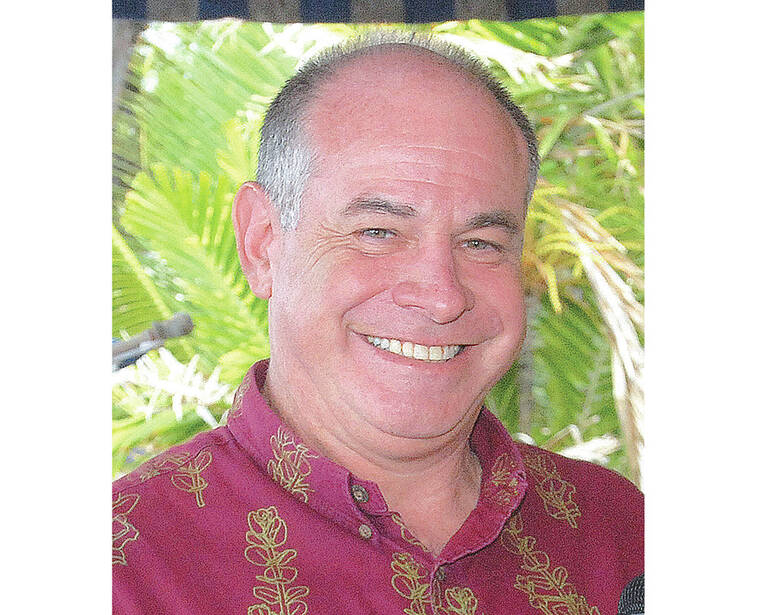Lava has destroyed 82 homes or structures and isolated an additional 37

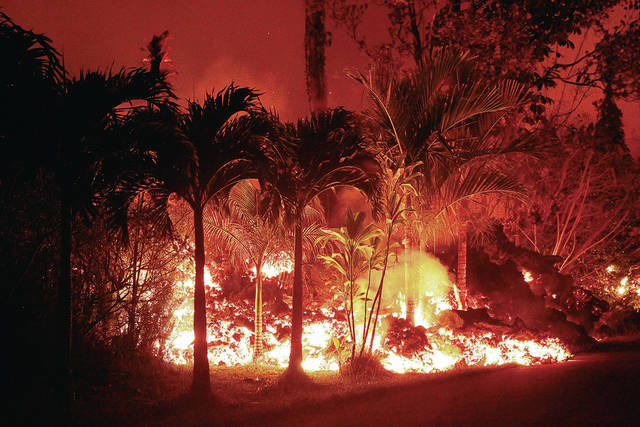
GEORGE F. LEE / GLEE@STARADVERTISER.COM
A lava flow overtook a row of palms Friday night on Mohala Street in Leilani Estates in Pahoa, Hawaii.
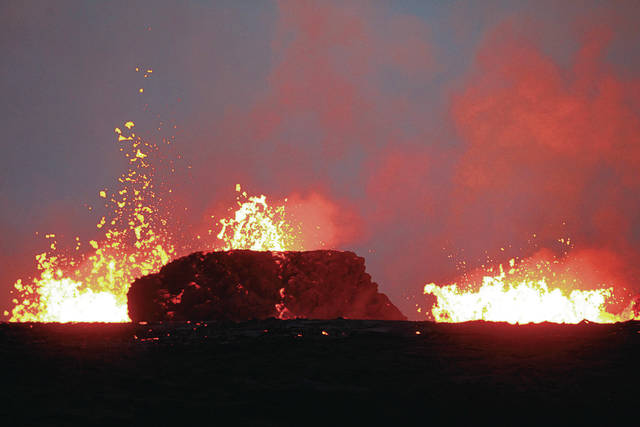
GEORGE F. LEE / GLEE@STARADVERTISER.COM
A lava show Friday night at the end of Leilani Street in Leilani Estates.
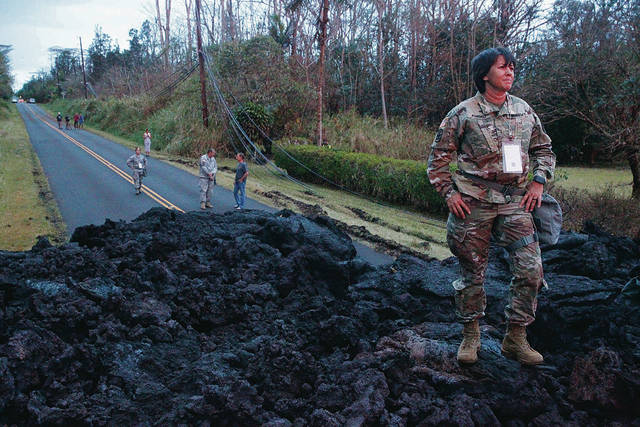
GEORGE F. LEE / GLEE@STARADVERTISER.COM
Leilani Estates continued to suffer the ravages of Pele on Friday near Pahoa, Hawaii. Army National Guardsman Chief Warrant Officer Kandee Almond stood atop a lava flow on Leilani Avenue.
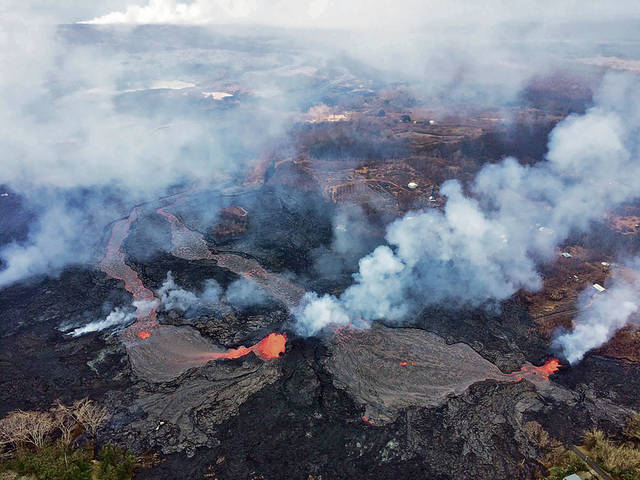
U.S. GEOLOGICAL SURVEY
An aerial view Friday of fissures 6 and 13 showed lava flows merging into one channel that flowed into the ocean at the westernmost entry.





PAHOA, HAWAII >>
More than 100 homes or other structures have now been destroyed or made unreachable by lava three weeks into an eruption that shows no signs of ceasing near the eastern tip of Hawaii island.
Hawaii County officials said Friday that 82 homes or other structures have been destroyed, up from a previous count near 50.
Officials also said that another 37 homes or other structures have been isolated by lava.
The latest assessments of damage to private property were provided by the county’s Real Property Tax Office and the Office of Housing and Community Development using a combination of aerial assessments and property records. They are the best tally available to date but do not distinguish between homes and other structures that could include storage buildings.
RELATED STORIES
Don't miss out on what's happening!
Stay in touch with breaking news, as it happens, conveniently in your email inbox. It's FREE!
>> Helicopters standing by for evacuation
>> Volcanic ash covers schools on Big Island
>> Blue flames from methane vents surprise scientists
>> Puna family still in shock; others hold on, hoping they’ll be spared
>> Evacuation by air could have Lower Puna residents out in hours, official says
>> Volcano could dent booming tourism industry
>> Puna man ‘just wanted to live’ after nearly losing leg to lava bomb
RELATED PHOTOS AND VIDEOS
>> Live webcams from Hawaii island
>> Photos: Lava in Leilani Estates and a look at the rescue helicopters, May 25
>> Photos: Lava in Leilani Estates, May 23
>> Photos: Lava approaches Puna Geothermal Venture, May 22
>> Photos: Pahoa community meeting, May 22
>> Video: Victor Hoapili talks as lava fountains erupt in his backyard
>> Video: Ken Szymanski talks about lava fissures in his neighborhood
COMPLETE KILAUEA COVERAGE
>> Star-Advertiser volcano coverage
>> Kilauea Volcano YouTube playlist
Talmadge Magno, county Civil Defense administrator, said the count could be higher because it doesn’t include structures destroyed over the prior 24 hours.
Most of the losses have been in the Leilani Estates subdivision where there are 700 to 900 homes, often on 1-acre lots. Some destroyed also have been in Lanipuna Gardens.
Magno said 230 people are in nearby shelters and that 200 or so people haven’t heeded a mandatory evacuation order.
County officials understand that some Leilani residents might not want to evacuate, especially because from parts of the vast rural subdivision, it isn’t visually apparent that lava has oozed or fountained from more than two dozen ground fissures over the last three weeks and formed streams leading to the ocean.
Still, Magno said people should seek safety. “The eruption continues,” he said. “That whole subdivision is vulnerable at this point.”
Earlier this week a man was seriously injured when a fiery rock blasted from a lava flow and shattered his lower leg while he was standing on the balcony of his home.
Magno said they might step up efforts to get people to leave their homes, and added that Hawaii County Fire Department officials visited three streets in the area Friday to make sure no one was in the homes because lava crossed Kahukai Street, one of the perimeter roads for Leilani Estates.
Kilauea Lower East Rift Zone Fissures and Flows, May 25 by Honolulu Star-Advertiser on Scribd
Staying put
Peter Masek, a 22-year Leilani Estates resident, said he’s outfitted with gas masks, a bug-out bag and a back-road way out if necessary. Because his home is far from the lava flows, his concern is only harmful gases if the prevailing tradewinds shift.
On Friday evening Masek was looking at the spouting lava as he has done just about every day. “This looks like the whole Kilauea caldera emptied out right here,” he said. “It’s insane to see this.”
Masek, who has built several homes at Leilani Estates that are now destroyed by lava, said the home of his daughter and ex-wife was cut off at the start of the magma outbreak. “It’s a lava flow right across Nohea (Street),” he said. “There’s no way to get over there.”
As for himself, Masek said he will remain unless lava claims his house. “I’m like the old-school guys,” he said. “Until it comes to my doorstep (I’ll stay). Then I’ll walk away and get on a plane.”
Fissure update
Overall, the ongoing flows of lava have covered 2,223 acres of land.
A flow originating near the center of the subdivision is moving to the northeast in a development that could threaten Highway 132, an important access road for authorities and an evacuation route for remaining residents.
The flow from fissure 21 has been moving north along Kaupili Street to about 200 yards south of Kahukai Street at the edge of the Leilani Estates subdivision, “but the flows are sluggish in the northeast direction,” said county spokeswoman Janet Snyder.
Wendy Stovall, a volcanologist with the U.S. Geological Survey, said lava in the area has built up into a pond that is about 9 feet above surrounding ground level and is inflating. Stovall expects minor overflows but not rapid movement.
Lava Breakouts Map by Honolulu Star-Advertiser on Scribd
Another lava breakout from the same fissure system has occurred nearer to Mohala Street, according to Snyder, and fissure 3 in the same area also has been active.
“If fissures start opening up north, we may have to look at inundation of (Highway) 132,” she said. That highway extends from Pahoa village to Kapoho and has become an increasingly important transportation route since lava severed Highway 137 on the Puna coast south of Pohoiki.
If Highway 132 is cut near its intersection with Pohoiki Road, Highway 137 along the coast from Kapoho to Hawaiian Beaches would become the last remaining route in and out of the Pohoiki and Kapoho areas.
Lava from fissure 22 continues to feed one lava river that is flowing into the ocean, while fissures 6 and 13 are feeding a second ocean entry, she said.
Meanwhile, fissures 7 and 21 are feeding a perched lava pond and flow of pāhoehoe lava — basaltic lava with a smooth or ropy surface — that has advanced eastward covering most of the area bounded by Leilani Boulevard, Mohala Street and the fissure line, according to the Hawaiian Volcano Observatory. Fissure 17 continues to spatter weakly, while Fissures 19 and 23 are no longer active.
At the Kilauea summit about 25 miles away, there were a series of strong explosions starting Thursday night at 6 and continuing Friday, but very few earthquakes, she said. Those ash eruptions have not released any lava, but have scattered a layer of ash across Pahala and other communities in Kau.
The National Weather Service issued an alert at 11:03 a.m. that trace ashfall remains possible from Kilauea. The communities of Pahala, Wood Valley and Naalehu are particularly likely to receive ash fallout as tradewinds push the ash southwest from Kilauea.
Volcanic gas emissions remain very high from the fissure eruptions. Additionally, tradewinds are forecast to slow over the weekend, creating hazardous air quality and decreased visibility conditions throughout the lower East Rift Zone, Hawaii County Civil Defense said. Volcanic gases, vog and ash emissions could increase over the weekend with higher levels of sulfur dioxide pooling in areas downwind of the vents, the agency said.


